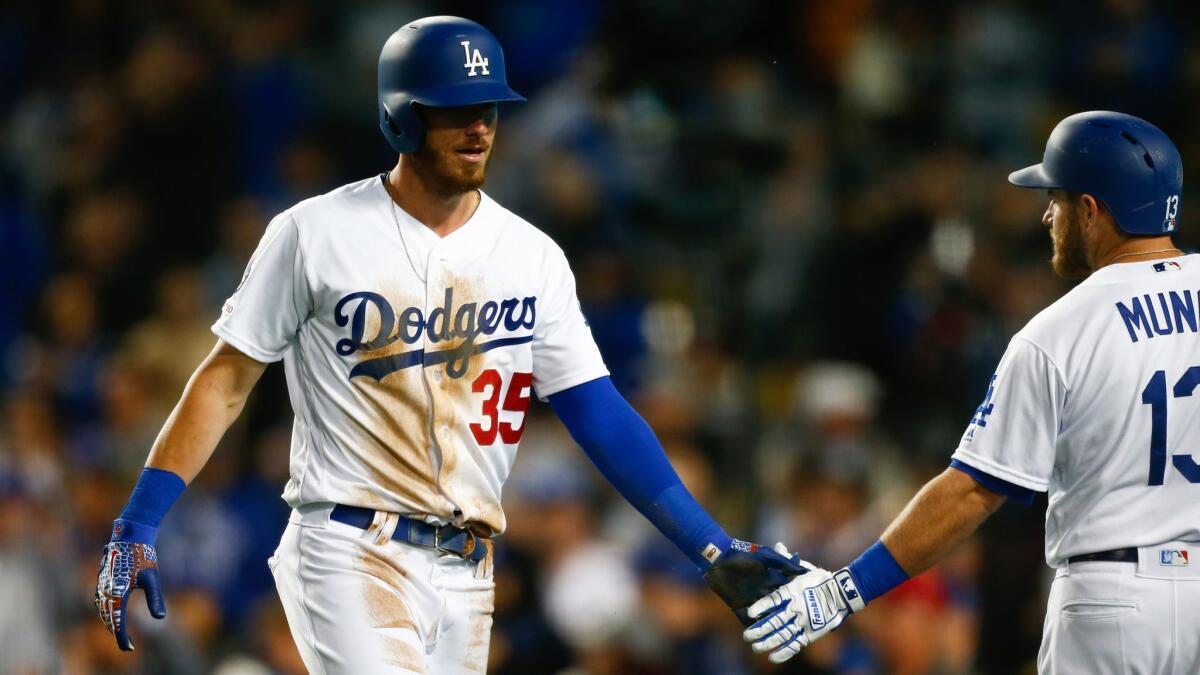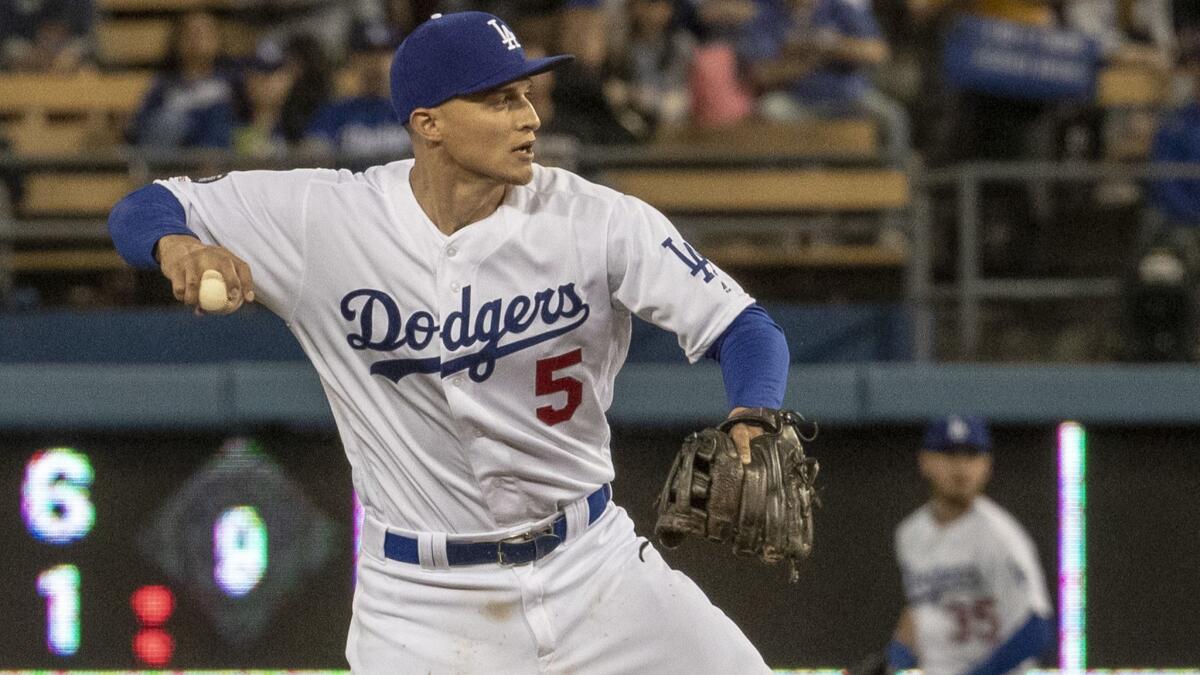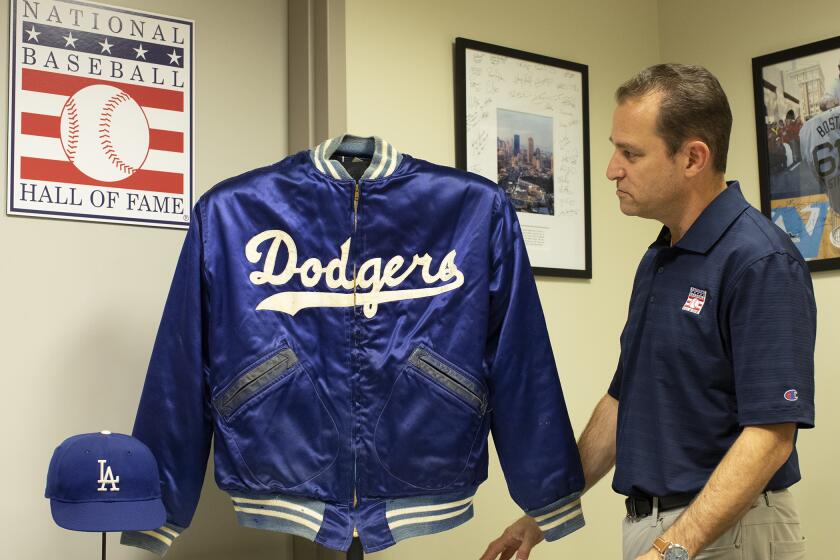Column: Andrew Friedman knows all about contract extensions, but will young Dodgers get them?

- Share via
Evan Longoria signed his name to a $17.5-million contract extension on the seventh day of his big-league career in the spring of 2008. In the years that followed, as his production with the Tampa Bay Rays soared and his salary stayed static, he did not dwell on the money he left on the table in arbitration. He did not worry about the three option years that delayed his free agency. He believed his financial security enhanced his performance.
“If I turned down that deal, if I went out and had a bad year that first year, I would have been like, ‘I should have taken the deal, I should have taken the deal,’” Longoria said. “To be able to go out there and not have to worry about getting sent down, to not have to worry about going 0 for 10 and not playing, the positives way outweighed the negatives for me.”
This spring, after a rancorous offseason between Major League Baseball teams and the labor force, a bevy of players have faced the same choice Longoria did. And the players have often reached the same decision Longoria made: They took the money.
The wave of extensions opened with Nolan Arenado agreeing to a $260-million deal with the Colorado Rockies. It peaked with Mike Trout’s 10-year, $360-million extension with the Angels. A year away from free agency, Paul Goldschmidt opted for a five-year, $130-million contract with the St. Louis Cardinals. Chris Sale eschewed the open market in similar circumstances, taking a five-year, $145-million deal with the Boston Red Sox. New York Mets ace Jacob deGrom and Houston Astros ace Justin Verlander took new deals, too.
The contracts were not limited to veterans approaching free agency. The Chicago White Sox moved top prospect Eloy Jimenez onto their opening day roster after he signed a six-year, $43-million contract with two option years. The Astros bought out Alex Bregman’s arbitration years plus two more seasons of control with a five-year, $100-million contract. The Atlanta Braves locked up National League rookie of the year Ronald Acuña Jr. with an eight-year, $100-million extension.
Standing on the sidelines throughout this stretch has been Dodgers president of baseball operations Andrew Friedman, the executive who signed Longoria to that extension in 2008. While running the Rays, Friedman prioritized inking his young players often before they even reached arbitration, giving up a financial guarantee in exchange for additional seasons of control. Besides Longoria, those players included pitchers Wade Davis, James Shields and Matt Moore and utility player Ben Zobrist.
Yet, since arriving in Los Angeles in the winter of 2014, Friedman has given only one extension to a player before free agency. That came last November, when Clayton Kershaw negotiated a three-year, $93-million contract during the window between the end of the World Series and the opening of the market. Kershaw wasn’t interested in leaving Los Angeles, but he leveraged his potential departure into essentially a one-year addition on his previous contract.
The Dodgers do not lack candidates for extensions. The roster features three young stars in Cody Bellinger, Walker Buehler and Corey Seager. There are also productive contributors in Enrique Hernandez, Max Muncy, Joc Pederson and Chris Taylor. Friedman suggested the dichotomy between his strategy in Tampa Bay and Los Angeles was “more circumstantial than anything philosophical.”
“There are certain players where giving that security allows them to blossom and play even better,” Friedman said. “And certain guys play really well with that carrot in front of their face, and that extra, added motivator helps get the most out of them. It’s imperative to figure out which group different guys fall into. But I wouldn’t be surprised if within the next 12 months we do some.”

The size of the market makes a difference. In Tampa Bay, Friedman sought financial certainty. The Rays might feel squeezed if a player did well in arbitration; they traded David Price in 2014 aware he would smash the record in a hearing that winter. In Los Angeles, even with the Dodgers wary of triggering the competitive balance tax, the organization can challenge players to perform and pay the price on a year-to-year basis.
“The good and bad about being a player in a big market is they can kind of just let you go through the arbitration process,” Kershaw said. “They don’t need a discount. That’s a situation that all of us are in with a big-market team. They’re not coming to you with a really discounted offer. They’re going to let you play through it — and you’ve got to play well, for a really long time.”
On the surface, Bregman’s $100-million extension, which was negotiated by his representatives from Tidal Sports Group, looks like a blueprint for a deal with Bellinger or Seager. Bregman, who turned 25 in March, produced 10.7 wins above replacement in his first two full seasons, according to Baseball-Reference.com. Bellinger, 23, was worth 8.4 WAR in his first two seasons; Seager, who turns 25 later this month, earned 11.5 WAR.
But Seager missed most of 2018 with elbow ligament reconstruction, which suppressed his salary to $4 million in his first round of arbitration. The lost season makes an extension difficult, because no one could guarantee how he would bounce back from surgery. Bellinger regressed at the plate in 2018, but still remained productive. The slight setbacks for both players are unlikely to sway their agent, Scott Boras, to pursue a team-friendly contract.
“I don’t know who Bregman’s agent is,” Kershaw said. “But I bet it’s not Scott Boras.”
Seated inside a suite at Angel Stadium last week, Boras chuckled at the notion he would never negotiate an extension. He had just returned from Seattle, where he took part in the announcement of a six-year, $132-million extension for Boston Red Sox shortstop Xander Bogaerts. The deal allows Bogaerts to opt out after 2022, and includes a $20-million vesting option.
Boras pointed toward Bogaerts’s deal, plus Elvis Andrus’ extension with the Texas Rangers and Stephen Strasburg’s with the Washington Nationals, as evidence that he lets his clients make their own decisions. If they want to stay with their teams, he explained, he will try to make that happen, but he also educates his players on how he believes the industry underestimates their value.
“Great young players are getting what I call ‘snuff contracts,’” Boras said. “And a snuff contract is that they’re trying to snuff out the market. They know the player is a great player, and he’s exhibited very little performance. So they’re coming to him at 20 and 21, and I’m going to snuff out your ability to move, to go anywhere, to do anything, and your value. And I’m going to pay you maybe 40 cents on the dollar to do it. What’s my risk?”
Boras described Acuña’s contract, in which the Braves will control their star through 2028, as “the king of the snuff contracts.” In Boras’ view, these deals set players loose in their 30s, when the rest of the sport no longer wants to give them long-term deals.
Sign up for our daily sports newsletter »
Seager can become a free agent at 28, as can Bellinger. Bregman would have been 29 when he reached the market before his new deal. That year made a significant difference, Boras suggested. He noted how Bryce Harper, as a free agent at 26, just consummated a 13-year, $330-million deal with the Phillies despite being worth only 1.3 WAR in 2018.
“This is like hitting,” Boras said. “You can be a great hitter, but if you’re out in front of the changeup? But if you know the changeup is coming, you have the skill to whack it out of the ballpark. The idea is you better know your pitches.”
Longoria opted for long-term security over receiving his full value on the open market. The Rays rewarded him in 2012 with a $100-million extension that ran through 2022 — a contract they subsequently dumped on the San Francisco Giants before the 2018 season. A decade after he signed his first deal, Longoria expressed no regrets.
“Looking back now, I do think about the impact that it’s going to have for future players, with current players,” Longoria said. “But, man, it’s really hard to turn down that much money when you’re that young.”
Twitter: @McCulloughTimes
More to Read
Are you a true-blue fan?
Get our Dodgers Dugout newsletter for insights, news and much more.
You may occasionally receive promotional content from the Los Angeles Times.










